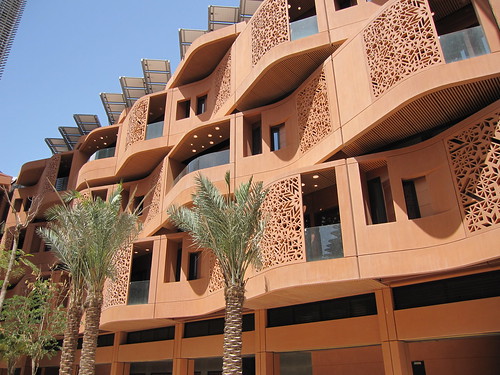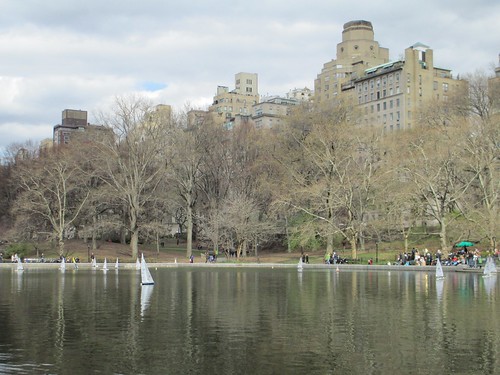I’ve long enjoyed pondering how living today measures up to
yesterday’s vision of tomorrow – and how it falls short. I can now receive
wirelessly once-unimaginable volumes of information – but poor software makes the
device responsible crash. I can find out almost whatever I want at the
press of a button – and I get it surrounded by links to stories about how celebrities
look without makeup. I can theoretically work as easily in a 150mph train as in
my office – but humans overload every system they build, so I can’t. It was
always smoother and cleaner in science fiction.
 |
| Sheikh Zayed Road: Bel Geddes' vision realised in a dusty desert dystopia |
Yet, even as a connoisseur of the former future’s shortcomings,
I was taken aback when I visited an exhibition on the work of Norman Bel Geddes, an early to mid-20th century futurist. I went to the exhibition
– at the fabulous Museum of the City of New York
– largely to let the six-year-old Invisible Visible Boy gawp at Bel Geddes’ plans
for streamlined bubble cars, vast flying boats carrying 500 passengers and a plan
for a floating air terminal off the tip of southern Manhattan . But suddenly, as I looked at one
of Bel Geddes’ plans for a future city, I saw a plan eerily similar to a place
I know – Dubai ’s
Sheikh Zayed Road
– staring back at me. The more I looked, the more I noticed how Bel Geddes’
strange, extreme visions for the future had shaped not only relatively exotic
places like Dubai but the environment I could see outside the museum’s Upper
East Side windows and that I’d known in other parts of the world.
The exhibition brought home to me a new version of a famous
quote from John Maynard Keynes. Practical men who believed themselves to be quite
exempt from any intellectual influence were “usually the slaves of some defunct
economist,” Keynes said. Town planners, it occurred to me, were normally grappling
similarly with some dead thinker’s vision of the future. The continuing legacy
of people like Bel Geddes – and people he influenced, like Robert Moses,
builder of much of contemporary New
York
My revenge on Bel Geddes had started even before I got to the museum,
though. Bel Geddes’ vision of the US in 1960 – unveiled at the 1939 World’s
Fair in Queens and sponsored, tellingly, by General Motors – envisaged a
country criss-crossed by highways with pretty much all transport provided by
some form of motor vehicle. Bel Geddes specifically called for creation of
urban motorways. “There should be no more reason for a motorist who is
passing through a city to slow down than there is for an airplane which is
passing over it,” Bel Geddes wrote. I scoffed at his ideas by enjoying a
12-mile cycle ride to the museum - over the Brooklyn
Bridge , up the Hudson River Greenway
and through Central Park .
But it was also clear once I’d visited the exhibition that I’d
ridden through some concrete-and-steel expressions of Bel Geddes’ ideas. As I headed north of 59th street ,
my cycle route ran under the Henry
Hudson Parkway , one of many freeways that Robert
Moses designed to realise a vision similar to Bel Geddes’ to cater to motor
cars. When I lived in London ,
I would sometimes cycle under the Westway, another urban motorway intended to
speed motorists through an urban landscape as if it wasn’t there. Glasgow , where I grew up,
has built so many urban motorways it sometimes feels as if there’s little city left.
Those visions of future utopias had become dystopias, it
occurred to me as I rode home, because of shortcomings that become obvious on
closer examination. In such visions of a smoothly-running automotive future,
cars are only ever shown moving, not parked. That’s not an omission that seems
credible to anyone who’s ever cycled around Brooklyn
on a street-cleaning day. Street after street clogs up as drivers double-park
their vehicles on the other side of the street to let the cleaning machine
past.
The cars also run an orderly distance from each other in
past visions of the future. At the World’s Fair, Bel Geddes made it clear that
he thought radio control by 1960 would be preventing cars from crashing into
each other. Pedestrians seem to have been out of the equation because Bel
Geddes thought they would all be on elevated walkways. Although pedestrians are
segregated on walkways in some places – like Hong Kong
– his vision is laughably at odds with the honking, disorderly reality of
contemporary urban roads.
However, the biggest failing of the former futurists’ vision
is that they fail to recognise how the future has to fit into past visions of
the present. It’s seldom possible to build a city from scratch with no regard
to the existing buildings and streets – although, of course, many of the attempts
to realise the futurists’ visions were made in cities razed by second world war
bombing. Only Robert Moses’ remarkable political power allowed him to demolish
so many New York
neighbourhoods to accommodate his grand road schemes.
 |
| Varick Street, lower Manhattan: Robert Moses would have liked to clear these pesky pedestrians away. |
It was the clash between the past and the future that
finally put a stop to Moses’ drive in New
York . A film at the Museum
of New York describes how his attempt
to build an expressway across lower Manhattan
foundered on the unlikely rock of Jane Jacobs, a writer and theorist who
organised opposition and had the scheme stopped. Jacobs loved the architecture
and streets of Greenwich Village , where she
lived, and thought the area’s townhouses and tenements worth preserving. There would be similar battles fought - some won, like the battle to stop Edinburgh's Old Town from being demolished for a motorway, and some lost - right across the developed world in the decades to come.
Even the United
Arab Emirates has started to realise that
car-dominated cities pose severe problems. There’s now a metro line along Sheikh Zayed Road ,
running above the cars. Last time I visited the UAE, I was also able to visit a
more Jane Jacobs-ish model of a Gulf city in Masdar, outside Abu Dhabi . While it features a rather Bel
Geddes-ish underground electric car system, Masdar is designed to replicate the
traditional urban patterns of middle eastern cities, with fountains, high stone
walls and structures designed to produce natural breezes. Cars are banned from
the heart of the town and the planners intend that cycling will be one of the
ways inhabitants get about.
 |
| Masdar: a Gulf vision Bel Geddes didn't inspire |
Few places, however, have the luxury of starting from
scratch as the Masdar planners have done. New York and other big cities consequently live with some of the kind of
old infrastructure that Jane Jacobs fought to preserve and some of the futurist
infrastructure that Robert Moses promoted. The challenge is to work out how best to adapt both to fit the future.
 |
| The Williamsburg Bridge's bike and pedestrian lanes: proof the future contains more bikes, but looks less neat, than Norman Bel Geddes envisioned |
The tension has struck me powerfully this week. There is
some excellent, new provision for me and my bike in contemporary New York , built by city
authorities who think the city in the future will need more people to get about
roughly the way I do. I’ve also, however, attended this week a protest calling
on the police to stop speeding drivers after the death on October 26 of Lucian Merryweather, hit by a speeding driver on a Fort Greene 2nd Avenue in Manhattan
and then onto the East River bike path.
The cars on 2nd
avenue , when not caught in a traffic jam, would
buzz me at intimidating speeds. Then, as I sought to get onto the East River bike path, I had to cross an off-ramp from FDR Drive , the kind
of urban expressway I’d seen staring back at me from Bel Geddes’ pictures.
The cars came roaring off the expressway into the city streets, most still running at a good 60mph. As I watched them, wondering when I would safely be able to cross, I thought of Norman Bel Geddes. Some of his vision now looks strange and much of it looks downright dangerous. But there remain many drivers who see no reason why a car should have to slow down just because it’s in a city.
The cars came roaring off the expressway into the city streets, most still running at a good 60mph. As I watched them, wondering when I would safely be able to cross, I thought of Norman Bel Geddes. Some of his vision now looks strange and much of it looks downright dangerous. But there remain many drivers who see no reason why a car should have to slow down just because it’s in a city.



I never dreamed I would one day WANT to live anywhere in Arabia, but there you go, I would live in Masdar. What a great idea.
ReplyDeleteBabble,
DeleteThank you for the comment.
In fairness, I should probably say that Masdar is on the edge of Abu Dhabi and, when I went there, it still didn't have a metro or other public transit connection to the rest of the city. So the only way to get there was driving. Which rather spoilt the point. But it's an exciting and attractive experiment, that's for sure.
Invisible.
I'm not sure I'd want to cycle in Masdan in the summer. 110F in DFW is plenty hot enough for me!
ReplyDeleteSteve A,
DeleteIt is pretty hot there, that's true. But the city is based on a lot of research showing how much the canyon street pattern of most modern North American cities (and most in the Gulf too) makes any place on the road feel so much hotter. It really feels a lot cooler in the shade than one might think.
Invisible.
A little late in responding, ("long time listener, first time caller, love the show, Steve") but I was reminded of the Usborne Book of the Future which I remember from when I was little - do seek it out if you're interested in the late 70s young adult version of where we'd be by now... really fun to read. (found an enormous pdf online - enjoy! http://life.enhasa.org/wp-content/uploads/2010/01/The%20Usborne%20Book%20of%20the%20Future.pdf - see for instance p. 38/39 - separated cycle lanes)
ReplyDeleteKeep up the good work, Mr Invisible, sir.
And the obligatory monorail, of course!
DeleteRob,
DeleteThank you for your kind words.
When I became my newspaper's transport correspondent in 2003, I made an unspoken vow to myself that I would never write a puff piece about how MagLev was going to be the wave of the future. I remembered how I'd seen such puff pieces growing up in the 1970s (No moving parts! It floats above the track!) and how they'd come to nothing. I didn't as consciously forswear monorail boosterism but I probably ought to have. They're both solutions to problems with conventional rail systems that aren't really problems.
But I love it that your book is so keen on cycling. I'm picturing some lone cycling enthusiast among the team who prepared the book telling the rest of them, "But, but - bikes make so much sense they have to be important in the future!" I just hope I'm right when I tell people the same today.
All the best,
Invisible.